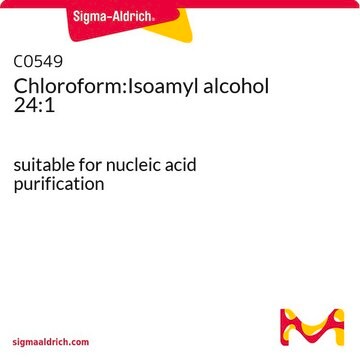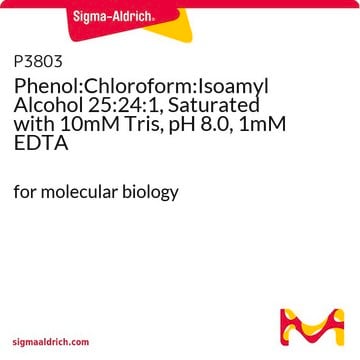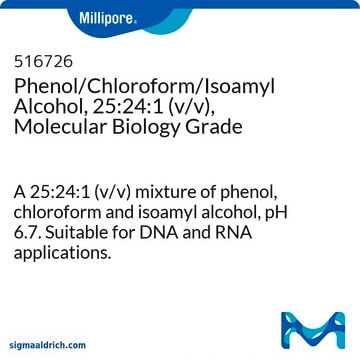25666
Chloroform – isoamyl alcohol mixture
24:1, ≥99.5%, for molecular biology, BioUltra
About This Item
Recommended Products
product name
Chloroform – isoamyl alcohol mixture, BioUltra, for molecular biology, 24:1, ≥99.5% (chloroform + isoamyl alcohol, GC)
grade
for molecular biology
Quality Level
product line
BioUltra
Assay
≥99.5% (chloroform + isoamyl alcohol, GC)
form
liquid
impurities
DNases, none detected
RNases, none detected
insoluble matter, passes filter test
phosphatases, none detected
proteases, none detected
≤0.001% free alkali (as NH3)
cation traces
Al: ≤0.5 mg/kg
Ba: ≤0.1 mg/kg
Bi: ≤0.1 mg/kg
Ca: ≤0.5 mg/kg
Cd: ≤0.05 mg/kg
Co: ≤0.02 mg/kg
Cr: ≤0.02 mg/kg
Cu: ≤0.02 mg/kg
Fe: ≤0.1 mg/kg
K: ≤0.5 mg/kg
Li: ≤0.1 mg/kg
Mg: ≤0.1 mg/kg
Mn: ≤0.02 mg/kg
Mo: ≤0.1 mg/kg
Na: ≤0.5 mg/kg
Ni: ≤0.02 mg/kg
Pb: ≤0.1 mg/kg
Zn: ≤0.1 mg/kg
λ
neat
UV absorption
λ: 260 nm Amax: 0.15
λ: 280 nm Amax: 0.1
SMILES string
ClC(Cl)Cl.CC(C)CCO
InChI
1S/C5H12O.CHCl3/c1-5(2)3-4-6;2-1(3)4/h5-6H,3-4H2,1-2H3;1H
InChI key
BKHZIBWEHPHYAI-UHFFFAOYSA-N
Looking for similar products? Visit Product Comparison Guide
Related Categories
Components
Signal Word
Danger
Hazard Statements
Precautionary Statements
Hazard Classifications
Acute Tox. 3 Inhalation - Acute Tox. 4 Oral - Carc. 2 - Eye Dam. 1 - Repr. 2 - Skin Irrit. 2 - STOT RE 1 Oral - STOT SE 3
Target Organs
Central nervous system, Liver,Kidney
Storage Class Code
6.1D - Non-combustible acute toxic Cat.3 / toxic hazardous materials or hazardous materials causing chronic effects
WGK
WGK 3
Flash Point(F)
Not applicable
Flash Point(C)
Not applicable
Regulatory Listings
Regulatory Listings are mainly provided for chemical products. Only limited information can be provided here for non-chemical products. No entry means none of the components are listed. It is the user’s obligation to ensure the safe and legal use of the product.
PRTR
Class I Designated Chemical Substances
ISHL Indicated Name
Substances Subject to be Indicated Names
ISHL Notified Names
Substances Subject to be Notified Names
JAN Code
25666-INTR:
25666-100ML:4548173223261
25666-BULK:
25666-500ML:4548173223278
25666-VAR:
Choose from one of the most recent versions:
Already Own This Product?
Find documentation for the products that you have recently purchased in the Document Library.
Customers Also Viewed
Our team of scientists has experience in all areas of research including Life Science, Material Science, Chemical Synthesis, Chromatography, Analytical and many others.
Contact Technical Service











